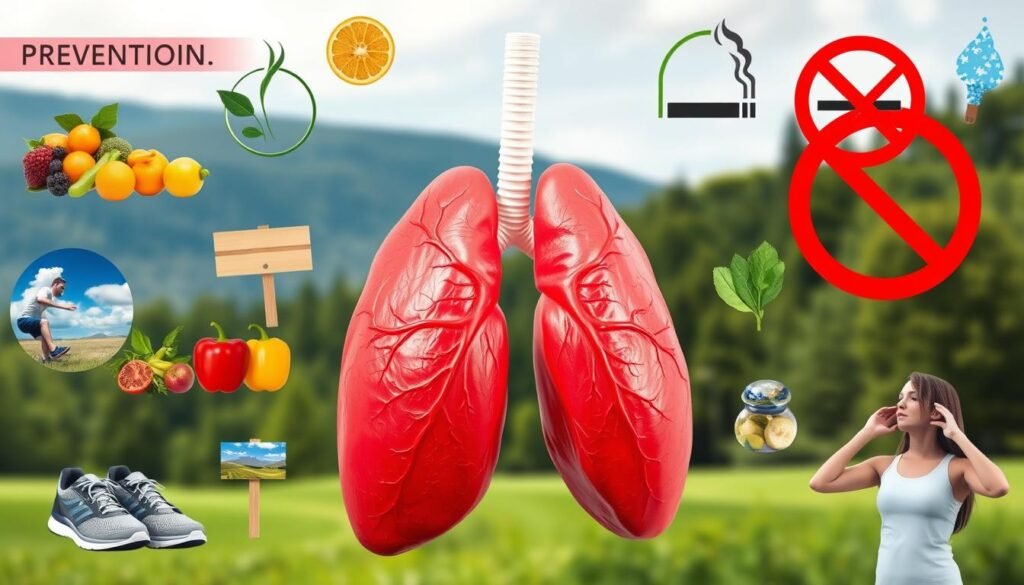Lung cancer is the top cause of cancer deaths around the world. It leads to about 1.8 million deaths each year. This fact shows we need strong ways to fight this disease.
Smoking is the biggest reason for lung cancers, causing 87% of them in men and 70% in women. Knowing how to prevent lung cancer is crucial. Taking proactive steps and making smart lifestyle changes can greatly lower your risk. This article will share important tips on preventing lung cancer. From stopping smoking to spotting environmental dangers, you’ll learn how to protect your health.
Key Takeaways
- Lung cancer leads to nearly 1.8 million deaths globally each year.
- Smokers have a dramatically increased risk for lung cancer.
- Early detection through screenings can significantly impact outcomes.
- Environmental and occupational factors play a key role in lung cancer risk.
- A nutritious diet and active lifestyle can help in prevention.
The Importance of Lung Cancer Prevention
Lung cancer is a major health problem in the United States. Nearly 9 in 10 cases are due to smoking. This fact shows how important quitting smoking is for preventing lung cancer. Spreading lung cancer awareness helps people make good health choices.
Secondhand smoke also increases lung cancer risk by 20% to 30%. Radon, a natural hazard, causes over 20,000 lung cancer deaths in the U.S. every year. Since 1 in 15 homes have high radon levels, knowing and acting on this can help prevent lung cancer.
Knowing these facts shows why quitting smoking matters. It also highlights the value of community action. Working together, communities can save lives and reduce the costs of lung cancer treatment. Educational efforts can create a culture of health, urging people to take charge of their health decisions.
Lung cancer is the top cancer killer, making prevention key. Each year, around 209,000 people are diagnosed and about 132,000 die from it. That’s why it’s vital to focus on lung cancer awareness. We should work towards a smoke-free world and healthier lives for all.
Understanding Risk Factors for Lung Cancer
Knowing what raises the risk of lung cancer is key to stopping it. Smoking is the biggest risk. It causes most lung cancer deaths. Smokers are much more likely to get lung cancer than nonsmokers.
Being around smoke even if you don’t smoke is also dangerous. It’s the third leading cause of lung cancer in the U.S. It shows why we need places where no one smokes to protect people’s health.
There are other dangers in the environment. Radon gas inside homes is a top cause for people who don’t smoke. If you smoke and live in a radon-prone area, your risk goes up even more. Pollution in the air is another problem. It’s linked to a small percentage of all lung cancers.
Some jobs raise the risk too. People who work with asbestos, arsenic, or diesel fumes are in danger. If you’ve had chest radiation and smoked, your risk for lung cancer is higher.
To fight lung cancer, we must understand these risks. Not knowing them makes people more open to harm. Teaching everyone about these risks is a big step in battling lung cancer.
How Can You Prevent Lung Cancer?
Preventing lung cancer involves avoiding tobacco and harmful substances. Healthy behaviors can lower developing this disease risk.
Quitting Smoking
Quitting smoking is a key way to reduce lung cancer risk. Smoking causes about 85% of lung cancer cases. Stopping smoking cuts lung cancer risk over time.
For those who have smoked heavily, not using tobacco for five years can cut their risk by 39%. Quitting smoking boosts lung health and overall well-being.
Limiting Exposure to Secondhand Smoke
Limiting secondhand smoke exposure is crucial. This smoke has carcinogens that harm non-smokers, causing over 7,000 lung cancer cases in the U.S. each year. Smoke-free spaces protect everyone’s health.
Supporting smoke-free areas benefits public health significantly.
Reducing Workplace Risks
Lowering workplace risks is important for lung cancer prevention. Workers exposed to carcinogens face higher risks. Employers should establish safety measures against these exposures.
Being proactive can safeguard employees from substances that cause lung issues and cancer.
For additional prevention tips, check out how to reduce your risk of lung cancer. These actions can lead to a healthier future for all.
Healthy Lifestyle Choices for Prevention
Choosing healthy lifestyle options is crucial for lung cancer prevention. A diet for lung cancer prevention with necessary nutrients helps lower the disease risk. Foods like fruits and veggies give antioxidants that fight cell damage. Yet, eating healthy can’t cancel out the risks from smoking.
Eating a Nutritious Diet
Adding many colorful fruits and vegetables to your diet boosts your health. It’s important to eat:
- Leafy greens packed with vitamins
- Cruciferous vegetables, such as broccoli and cabbage, with cancer-fighting elements
- Fruits loaded with antioxidants, like berries and citrus fruits
Focusing on a diet for lung cancer prevention lets your body effectively resist diseases, including cancer.
Maintaining an Active Lifestyle
Being physically active is key to lung cancer prevention. Research shows staying active could cut your lung cancer risk by 20 to 50%. Activities like walking, swimming, or biking improve your health. To be more active, you can:
- Set real exercise goals
- Join community fitness programs
- Find fun activities for regular exercise

Adding short, light exercises into your day can also fight tiredness and lift your spirits. It shows how staying active greatly helps against lung cancer. By following these habits, you build a strong defense against lung cancer.
Avoiding Environmental Hazards
Environmental hazards significantly increase lung cancer risk. Radon exposure is especially key. This radioactive gas can build up in homes unnoticed.
To fight this risk, it’s crucial for homeowners to test for radon. Checking your living spaces can make a big difference.
Testing for Radon in Your Home
Testing for radon is key in preventing lung cancer from environmental causes. Radon test kits are available at many shops. These kits help homeowners check for radon levels at home.
If you find radon, you can install systems to lower it. This reduces your health risks.
Reducing Air Pollution Exposure
Reducing air pollution exposure is also important. Support local efforts for cleaner air. Better air quality benefits everyone.
Working together can help lower lung cancer from polluted environments. You can help by improving the air inside your home or joining community actions. For more tips, check out how to reduce air pollution.
Essential Lung Cancer Prevention Habits
Adopting daily lung cancer prevention habits is crucial for your health. Regular health screenings can catch lung cancer early. This makes treatment more effective. Getting frequent health checks provides insight into your lung health. It helps catch any issues early.
Regular Health Screenings
Screenings can find lung problems before they get worse. Doctors advise these checks to spot issues early. Talk to your doctor to set up a screening plan based on your risk. You can find info on good nutrition, exercise, and healthy habits from trusted organizations to improve overall health.
Staying Informed and Engaged in Community Health Efforts
Being active in your community helps prevent lung cancer. Join local cancer awareness or health events to learn about prevention. Talking about lung health with others spreads helpful tips. Working together, we can all support each other to live healthier and prevent lung cancer.

Best Practices to Prevent Lung Cancer
Effective strategies are key to reducing lung cancer risk. Two major practices include creating smoke-free areas and pushing for better air quality. These steps protect our health and help achieve public health goals.
Create a Smoke-Free Environment
Smoke-free zones are crucial in preventing lung cancer. They protect non-smokers from secondhand smoke’s dangers, full of cancer-causing agents. By supporting laws for smoke-free indoor and public places, we cut down on harmful exposure.
This helps everyone live a healthier life.
Advocate for Better Air Quality Standards
Fighting for better air quality is essential in combating lung cancer. Cleaner air standards can drastically reduce lung cancer cases. Promoting public transport and strict emissions rules are ways to fight pollution.
Supporting these efforts leads to improved health for everyone. Being aware of air quality research and policies is crucial.
Through these approaches, we’re lowering lung cancer rates and making a better future. Talking about prevention and ongoing research helps us understand lung cancer better. This improves care and patient outcomes.
Find out more about the newest treatments and research by visiting latest treatments and understanding lung cancer.
Prevent Lung Cancer Naturally with Alternative Approaches
More people are looking into natural ways to keep their lungs healthy. They want to avoid lung cancer using diet changes and wellness practices. These methods may help maintain health and possibly prevent lung cancer naturally.
The Role of Herbal Supplements and Diet
Though evidence is limited, certain foods might lower cancer risk. Grape seeds and pomegranate extract are promising, according to studies. A diet with lots of fruits, veggies, and grains is good for your immune system and lungs.
Herbal supplements might improve health too. But it’s important to talk to doctors before starting them. They ensure these natural choices don’t clash with other treatments.
Mindfulness and Stress Management Techniques
Keeping stress low is key for good health. Use yoga, meditation, and biofeedback to stay calm and relaxed. Studies show this could help stop lung cancer. These methods support both mental and physical health, making you stronger.
There is backing for these alternative ideas at alternative treatments for lung cancer. A well-rounded health plan with these strategies could improve life quality. It may even lessen cancer risk.

Clinical Trials and Research in Lung Cancer Prevention
Clinical trials are key in lung cancer research. They look for better ways to prevent lung cancer. This includes testing new drugs and ways to screen for the disease. Insights from these trials help improve public health and allow people to make better health choices.
In the U.S., smoking is the biggest cause of lung cancer. It’s linked to almost 90% of cases. People who smoke a lot or quit in the last 15 years should get yearly lung cancer screenings. These screenings use low-dose CT scans and are key in catching the disease early.
Research on lung cancer is always moving forward. Groups like the American Lung Association fund projects that aim to prevent, treat, and improve the lives of patients. With the Lung Cancer Interception Dream Team, experts are coming together to find new solutions.
Taking part in clinical trials gives patients access to the latest treatments. It also helps gather important data for research. For more information, patients can look into the Lung Cancer Clinical Trials Matching Service. This service offers personalized advice on clinical trials.
| Type of Study | Main Focus | Examples |
|---|---|---|
| Intervention Trials | Testing new drugs and therapies | PARP inhibitors for Small Cell Lung Cancer |
| Screening Trials | Evaluating screening methods | Low-dose CT scans for high-risk individuals |
| Observational Studies | Understanding disease progression | Lung Cancer Registry data analysis |
| Genetic Studies | Investigating genetic factors | GEMINI database for patient data |
Conclusion
The battle against lung cancer is tough but vital. Every two minutes, someone in the U.S. is diagnosed with lung cancer. It’s important to use a full approach to prevent lung cancer. This means knowing the risks and taking steps to stay healthy. Even though lung cancer is the main cause of cancer deaths, living healthy and getting checked regularly can make a big difference. These actions help people be more aware of their health and take control.
There’s good news on the horizon for fighting lung cancer. The survival rate has gone up by 26% in the last five years, now at 28.4%. Annual low-dose CT scans can lower death rates by 20%. This shows why it’s key to do more screenings. But not enough people are getting screened across the U.S. We need to educate communities more. Doing so can save lives and cut health care costs.
To really fight lung cancer, we need to focus on staying informed and getting screened often. By working together and committing to our health, we can reduce lung cancer numbers. This will not only help lower rates but also give communities the knowledge to prevent lung cancer. Looking after our health today means a hopeful and healthy future for everyone touched by this disease.